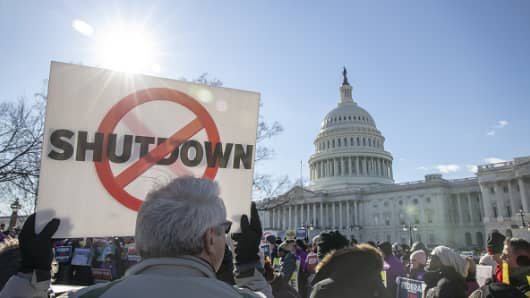When Jason Sherman decided to start his own company to make beer from micro-craft brewers more accessible, he never imagined that a federal government shutdown could affect his business.
Until late December, everything was going as planned for the Brooklyn, New York-based company named TapRm.
The company distributes beer to bars and restaurants. It also ships beer to residences; home deliveries are made from the TapRm’s original Rochester, New York, location.
And it’s just getting started on the third leg of the business: a Brooklyn storefront that will feature beer brands from around the country and the world.
The store is leased and all set up. But there’s a problem: The existing license TapRm has needs to be transferred from Rochester to Brooklyn in order to open.
The company, with two full-time employees, including Sherman, submitted an application to the Alcohol and Tobacco Tax and Trade Bureau in November. And then the shutdown happened.
“We were probably supposed to be approved four weeks ago now, yet I haven’t heard anything,” Sherman said. “There’s nobody to answer the phone right now.”
For every day the shutdown continues and the licensing is delayed, TapRm loses $1,500 to $2,000, Sherman estimates.
That’s after the young businessman, 31, put in $250,000 — including the inheritance he received after his parents passed away — into the company.
“It’s only a matter of time before there’s nothing left, because there’s no revenue coming in from the retail store,” Sherman said.
Like many small-business owners, Sherman has been caught off guard by how much the shutdown has impacted his bottom line.
“Especially if you don’t work for the federal government — in fact, you don’t work for anyone — you don’t necessarily think it’s going to have such a dramatic impact,” Sherman said.
That same sentiment is being felt by many other small-business owners across the country — those who do not rely directly on the federal government for business, but have found themselves in the crosshairs of a political stalemate that could continue indefinitely.
“It’s devastating,” said Keith Hall, president and CEO of the National Association for the Self-Employed, whose members mostly include small businesses with few, if any, employees.
“Even if it’s not chipping away at the income of a small business owner in Kansas, it is chipping away at their confidence that we can continue to move forward with the growing economy,” Hall said.
Aircraft delivery company Jet Test and Transport has also seen the effects of the shutdown, due to paperwork that can’t be processed.
The biggest part of the company’s business, according to managing director Steve Giordano, is transporting aircraft without people or cargo on board. Jet Test operates the planes as an intermediate party, which requires a one-time authorization from the Federal Aviation Administration.
Those authorizations are provided either directly from the FAA or through a designated airworthiness representative, or DAR.
In a Catch-22, the DARs report directly to the FAA, and the FAA inspectors who commission the DARs are unavailable. As a result, Jet Test flights that require special airworthiness certificates are completely unable to operate right now.
For example, the company has two planes in France that are waiting to fly to Brazil, but can’t go anywhere because they are registered with the U.S.
“Right now, it’s cost me $340,000 in revenue, which is probably about $90,000 in profit,” Giordano said of the shutdown’s impact on his bottom line so far.
More from Personal Finance:
What to know before you take out a loan against your tax refund
For furloughed workers, here’s how to get by without a paycheck
With no end in sight for the shutdown, thousands of federal workers file for unemployment
The Henderson, Nevada-based company, with eight employees, can still fly foreign-registered planes. But about 80 percent of their business is FAA-related, Giordano said.
“We had a really good year last year,” Giordano said. “We can kind of ride that wave.
“If it drags on more than a month, it’s definitely going to have an impact.”
Even if the shutdown ends today, companies like Tap Rm and Jet Test will likely still have to wait as the respective agencies they’re waiting on work through a backlog of paperwork.
In the meantime, there are steps that owners of small businesses facing a cash crunch may want to consider to help lighten their financial burdens.
Contents
Increase lines of credit
Shon P. Anderson, chief wealth strategist at Anderson Financial Strategies, said his Dayton, Ohio, firm is in an area with a lot of government contractors.
To start, businesses should look at increasing any existing lines of credit, Anderson said. That is because when you request that increase, the banks will look at your recent cash flows and payments.
“The sooner that you can get those increases approved, the better your financials look without having to key in on the concern that there may not be cash flow for an entire quarter for pieces of the business,” Anderson said.
Put a hold on purchases
In order to preserve the cash you still do have, try to hold off on making new purchases, Anderson suggested.
That includes delaying vendor payments as long as possible, he said, which is usually about 60 days.
Borrow from retirement accounts with caution
If you take a distribution from your individual retirement account or other retirement plan, you have 60 days to pay it back.
If you think that’s a reasonable amount of time to recoup the money you plan to use, you may want to try it. But proceed with caution, said Ivory Johnson, founder of Delancey Wealth Management in Washington, D.C.
“Watch out for not having the money within 60 days,” Johnson said. “That’s the gamble: What if you don’t get paid within 60 days?”
[“source-“forbes”]






















































